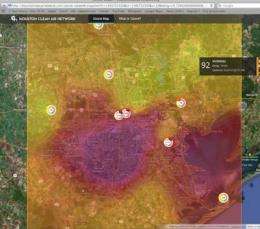This is a screen shot of Houston Clean Air Network's ozone map. Credit: Courtesy of the University of Houston
The extreme Texas heat often keeps Houstonians from heading to the park or taking an afternoon jog. Sometimes, however, they're dissuaded from outdoor activities due to poor air quality.
Now, residents of the greater Houston area can track ozone levels through the Houston Clean Air Network. Sponsored by a three-year $450,000 grant from Houston Endowment, this website (http://houstoncleanairnetwork.org) provides real-time air quality updates using maps of the region. It was developed by University of Houston professors in partnership with the American Lung Association of the Plains-Gulf Region and Air Alliance Houston.
When users visit the Houston Clean Air Network, they are greeted with educational content that defines the ozone and its effect on the human body. The site's content also explains how ozone can be managed and the precautions one should take if he or she is sensitive to poor air quality.
At the top of the page is a link titled Ozone Map, which takes users to a real-time map of the greater Houston area. On the right hand side of the page is a color key reflecting ozone conditions (purple representing "hazardous" and green indicating "good"). At the bottom left-hand side of the Ozone Map page, users will find a field titled "Set Time/Place." Here, they can enter a specific Houston address where they wish to check air quality levels. The address will then be marked on the map for future site visits. Another field allows users to check past dates and times for air quality.
The Texas Commission on Environmental Quality provides the site's air quality data. A team of UH faculty and staff directed by Dan Price, professor in UH's Honors College and philosophy department, developed the site along with Air Alliance Houston and American Lung Association staff. Other principal UH contributors include Barry Lefer, associate professor of atmospheric science, and staff members from the university's Texas Learning and Computation Center.
"This site allows people to plan their day," Price said. "It can be used by anyone with health concerns about ozone including educators who decide whether to hold school recesses outside or coaches who determine when outdoor practices are held. It can also benefit those living with respiratory illnesses such as asthma."
Price added that the site also can be used as a resource for researchers or medical professionals to track air quality data for epidemiological studies or other projects.
Provided by University of Houston



















